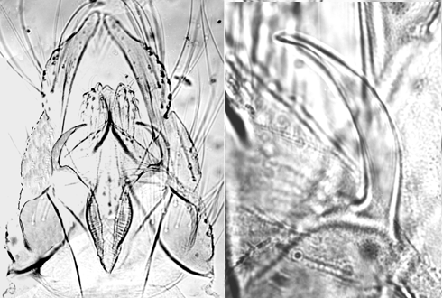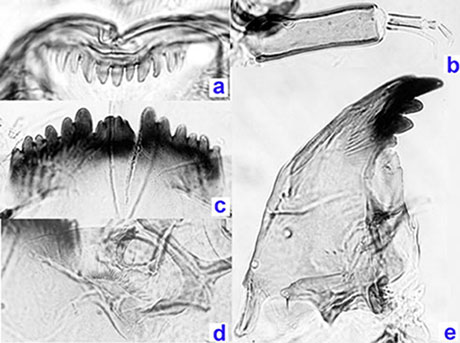Species 3i. C. decorus group?Only 3 larvae are known for certain. The possible male is in the Sublette collection at the University of Minnesota. Adult: This reared specimen not necessarily associated as other species were also present and the larva of this male is not known.  Male terminalia of C. ?sp. 3i (left) and superior appendage (right) Male terminalia of C. ?sp. 3i (left) and superior appendage (right)About 6 setae on TIX, possibly in separate pale areas. Anal point relatively broad, parallel sided. Superior volsella of E-type (g) of Strenzke (1959) - i.e. as C. cingulatus; Inferior volsella about as long as the anal point and to about 1/3 of the gonostylus, which narrows relatively sharply over distal third. Female: Not known.Pupa: Known only from caudolateral spur of segment VIII of the exvium of the reared male, which is relatively long with perhaps 3 spines - a longer central one and a much shorter one on each side.  Spur of pupal exuvium Spur of pupal exuviumFourth instar larva a medium sized plumosus-type (about 10.1-15.3 mm);the larva from Sudbury was the smallest, but it was also parasitised. Ventral tubules relatively long, posterior pair longer (ant. 1.20-2.64, post. 1.30-2.86 mm). Gular region slightly dark to dark on posterior1/3-1/2, slightly wider than the mentum and widest at the posterior margin; frontoclypeus pale. Oesophageal opening 63-83 µm wide and 3.3-4.2 times wider than deep.  Cytology: 4 polytene chromosomes with thummi arm combination AB, CD, EF, G. Arm E: 1 - 3e, ?? 7 - 6, 9 - 8, 12 - 13Arm F: 1 - 8, ?? 13 - 11, 16 - 23 possibly as C. dorsalis  Found: Ontario - 4 m E. Sudbury(46.52°N, 80.90°W). This species was not found in the Proulx et al. (2013) samples from the Sudbury area, possibly because these were samples from lakes. Shows some similarities to C. stigmaterus, which might indicate that the male (above) belongs to that species (although the species has not been recorded from Canada). The larva can be distinguished by the normally darkened frontoclypeus; longer A1 (3-3.94 longer than wide) and the more fully developed 3rd inner tooth of the mandible of C. stigmaterus . It also shares the only nucleolus being near the centromere of arm D, but other sequences, particularly arm A are different. The only other known Nearctic species with a nucleolus in arm D is C. utahensis, which is considered a member of the cytological C. decorus group, but not morphologically similar (Wülker, Sublette & Martin, 1991). |
Modified: 7 October 2024
Access: Unrestricted
Copyright © 2000-2024, Jon Martin.